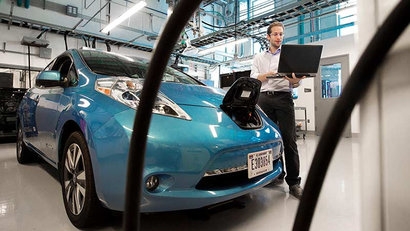
Matteo Muratori, a transportation and energy systems engineer at NREL and author of the new Nature Energy paper, “Impact of Uncoordinated Plug-in Electric Vehicle Charging on Residential Power Demand,” has created a computer simulation to explore the effects of in-home charging on the grid and found that, currently, an influx of plug-in electric vehicles charging without coordination could prove challenging to the nation’s electric grid.
The simulation concluded that a PEV market share of up to 3 percent, which translates to about 7.5 million vehicles, does not significantly impact the aggregate residential power demand. More than 600,000 plug-in electric vehicles were already on the road at the end of 2016, a figure that includes about 150,000 sold during the year.
However, Muratori also looked at the impact PEV charging might have on a residential distribution transformer. In this case, a problem arises when motorists gathered in a geographic area began buying these vehicles and plugging them in to recharge upon returning home - a practice known as uncoordinated charging. Even without large numbers of PEVs on the road, this clustering effect “will significantly increase the peak demand seen by distribution transformers and might require upgrades to the electricity distribution infrastructure,” according to Muratori’s paper.
“Previous research into the amount of energy required by homes hasn’t taken into account plug-in electric vehicles,” said Muratori, who holds a Ph.D. in mechanical engineering. “Given that more people are choosing to drive these types of vehicles and charging them at home, this additional demand should not be overlooked.”
Johney Green Jr., NREL’s associate lab director for Mechanical and Thermal Engineering Sciences, added that realising the full benefits of vehicle electrification will necessitate a systems-level approach that treats vehicles, buildings, and the grid as an integrated network.
The research also looked at whether the household used the less-powerful Level 1 charging option or the more-powerful - and therefore faster - Level 2 charging option. Muratori found that as more PEVs are added to a neighbourhood, and a higher charging power is adopted, “the distribution infrastructure might no longer reliably support the local electricity demand.” He also noted the higher demand could shorten the expected life of a transformer.
The electric load profiles used in this paper, including household demand and PEV charging with a 10-minute resolution, are available for download in the NREL Data Catalog.
Earlier studies on how PEVs might affect the grid assumed utilities would have some control over when charging occurs, referred to as coordinated charging, which will greatly facilitate PEV integration. Muratori noted that might be true in the future, but not necessarily. His research didn’t focus on using PEVs to return a battery charge to the grid to increase the reliability of the electric system. Future research, Muratori said, should focus on understanding consumer behavior to determine charging requirements, and the choice between using Level 1 and Level 2 residential charging equipment.
“Matteo’s work raises important issues for a world with increasing electrification of the vehicle fleet, and leaves us with clear avenues for additional research,” said John Farrell, NREL’s laboratory programme manager for vehicle technologies. “We need to continue looking at the synergies between electric vehicles and buildings, especially to make sure the grid remains safe and resilient.”
Image: NREL engineer Matteo Muratori, author of the new Nature Energy paper "Impact of Uncoordinated Plug-in Electric Vehicle Charging on Residential Power Demand," (Photo by Dennis Schroeder / NREL).
For additional information:

